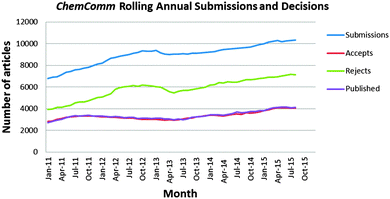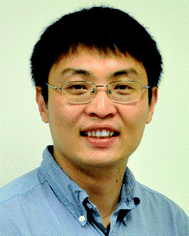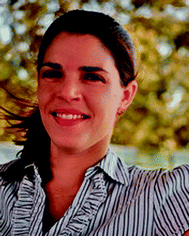Happy New Year from ChemComm
Abstract
Happy New Year to all our authors, readers and reviewers. In this Editorial, we introduce some updated guidelines for authors and readers on the criteria for publication in ChemComm.
Happy New Year to all our authors, readers and reviewers. In this Editorial, we outline the development of the journal over the past 10 years, and introduce some updated guidelines on the criteria for publication in ChemComm. We hope that these new guidelines will ensure that ChemComm continues to serve the community as the premier journal for the urgent publication of communications from across the chemical sciences.
Ten years of growth in size and quality
ChemComm has been on quite a journey of development over the past 10 years. It has grown from publishing 1279 articles in 2006 to over 3800 communications in 2015, a growth of nearly 200 per cent. Over this time, we have kept the acceptance criteria and rejection rate for the journal relatively stable at around 65%, and so this growth in publications has been a result of significantly rising submissions (Fig. 1).When you consider the trend of rising research output across all chemistry journals as seen in Web of Science™, it is unsurprising that we have seen such a dramatic growth in content in ChemComm. With this has come a significant change in the demographic of our authors. I'm proud that the journal has evolved here too, and this is a good reflection of the identity of the chemical research community today.
Joining the journal as the new Executive Editor in April, this year has provided me and the Editorial Board with an opportunity to take a step back and assess how we would like to see the journal develop in 2016, and in the longer term. Our main aims for the journal of publishing the highest quality communications which have significance and breadth across the chemical sciences, with market-leading speed as well as providing support for the community and emerging researchers, remain unchanged.
We appreciate that Impact Factors continue to be uppermost in authors' minds when they consider where to publish, and this of course will continue to be of great importance to the journal. With an Impact Factor of 6.834 (2014 InCites™ Journal Citation Reports ®), ChemComm is currently in the top 20 of the multidisciplinary chemistry category. As our flagship journal for the publication of communications here at the Royal Society of Chemistry, we recognise the importance of ChemComm remaining in this leading group of journals, and we encourage both our authors and reviewers to consider this when submitting or reviewing for ChemComm.
As our flagship communications journal, ChemComm is complementary to its sister journals Chemical Science, which publishes fuller accounts of chemical research of the most exceptional significance in the form of Edge articles, and Chemical Society Reviews which publishes high impact reviews across the breadth of the chemical sciences.
Acceptance criteria for publication in ChemComm – an update
Reviewers are crucial in helping us to maintain, and indeed enhance, the quality of work published in the journal, and we cannot function without an efficient and reliable review process. We appreciate that such activities can take good reviewers a significant amount of time – often requiring them to make and defend difficult decisions. The Editorial Board is acutely conscious of the reviewers' efforts and is most grateful to them for the very significant contribution they make to the journal.It is the view of the Editorial team and Editorial Board that ChemComm should be accepting only the very best work that is submitted to the journal. For publication, research should now be in the top 25% in terms of significance and originality for research in that particular field, and also of interest to a broad chemistry audience. If articles submitted to the journal meet these quality and significance criteria, then they will be accepted. Decisions will not be made based on a specified acceptance rate or limitation on number of articles.
Work that reports significant results, but which is more specialised in nature, should be considered for publication in one of our other journals at the Royal Society of Chemistry, and we are happy to work with authors to help them find the right home for this kind of research through the transfer system.
In order to help support our reviewers with this change, we have included this updated acceptance criteria on each manuscript which is sent for review, as well as some updated questions on the reviewer report form. When asked to consider the significance of the work in the communication, reviewers will have two options: highly significant, and significant for a broad audience. These two options will be a recommendation that the work is suitable for publication in ChemComm. There is also an additional option to recommend that the work is significant, but is more suitable for a specialised audience. This will help us to find a transfer to a more suitable journal within the Royal Society of Chemistry, should the authors wish to take up this offer. Routine work, however competently researched and reported, continues not to be suitable for publication in ChemComm.
In general, we will also be looking for at least two positive endorsements from reviewers for publication in ChemComm. This criterion means that an Editor may feel it is appropriate to reject or redirect a paper in the light of clear and valid criticisms made by one referee even if a second referee is supportive of publication.
It is our expectation that if authors are provided with detailed feedback for major revisions from the Editor, a revised manuscript will have addressed all points, either as revisions or additions to the manuscript itself, or if the authors feel it is not appropriate, that this has been clearly explained in an accompanying cover letter. In the majority of cases, all changes that are required for publication should be made within one round of revision.
We would also like to remind authors and reviewers that it is still important to make sure the main results of the research are communicated within the 4 pages of the communication, without relying excessively on details which can be found in the Electronic Supplementary Information (ESI). If we believe that a piece of research would be better told in a full paper format, then we will be working with authors to publish their work in one of our subject-specific journals.
We hope that these changes will help reviewers to communicate their thoughts around the article to the Editors, as well providing authors with a clearer justification for the final decision made on their manuscript. We would love to hear your feedback on these changes, and whether they are useful in this regard.
The ChemComm community
A sense of community has always been important in ChemComm, and we have strived to develop this with ChemComm Symposia, our Emerging Investigator Lectureships and the Emerging Investigator issues. Watch out for the sixth issue in this series in 2016. If you are interested in submitting to the issue please contact the ChemComm Editorial Office in the first instance; the deadline for submission is 18 January 2016.The Emerging Investigator Lectureships, which are awarded annually, recognise emerging scientists in the early stages of their independent academic careers. In 2015, we have awarded two ChemComm Emerging Investigator Lectureships to Deanna D'Alessandro (synthetic inorganic chemistry and molecular materials), University of Sydney, Australia, and Yong Sheng Zhao (organic nanophotonic materials), Institute of Chemistry, Chinese Academy of Sciences, China. Congratulations to Deanna and Yong Sheng!
Yong Sheng Zhao
Yong Sheng was presented with his official Lectureship at the Royal Society of Chemistry's 2nd Asian-European Symposium on Organic Optoelectronics on 27–29 October 2015 in Edinburgh.
Deanna D'Alessandro
Deanna will deliver her Lecture at a symposium entitled Metal–Organic Frameworks: Synthesis, Properties and Applications at Pacifichem 2015 in Hawaii in December.
We receive a large volume of high calibre nominations and the Lectureship has become very competitive. From 2016, we will be combining the nomination and selection processes for these Lectureships with those of our other general chemistry flagship journals at the Royal Society of Chemistry. Nominations for the 2016 Lectureships will be open shortly.
The 2015 ChemComm Symposium was held earlier this year in South Korea, at UNIST and Ewha Womens University in Seoul. These symposia not only provide us with the opportunity to connect with authors, readers and reviewers in various places, but also act as an opportunity to bring together researchers, allowing a number of international as well as local speakers to network and discuss the latest progress in their field. We will be continuing to hold ChemComm Symposia every 2 years.
New Associate Editor
In 2015 we have also added to our Editorial Board, and I'd like to take this opportunity to welcome Professor Amy Prieto to the Editorial Board of ChemComm, as an Associate Editor. Amy is from Colorado State University, and has a wide-ranging publication record. She is also the founder and Chief Executive Officer of Prieto Battery, Inc. Amy would welcome communications from authors who publish in the field of batteries and renewable energy.Authors have the choice to either submit directly to an Associate Editor or to our professional Editors in the Cambridge Editorial Office. This flexibility allows authors to choose their preferred choice of Editor, subject to availability, upon submission.
Thank you to authors and reviewers
I'd also like to take this opportunity to thank all our authors and reviewers, who do such an amazing in job in helping us to publish the most urgent communications from across the chemical sciences. As always, we welcome feedback or suggestions for the improvement of the journal; please do not hesitate to get in touch with me if you would like to discuss any aspect of publishing in ChemComm. Please do contact us at E-mail: chemcomm-rsc@rsc.org.Finally, from all the ChemComm team and Associate Editors, we would like to wish you a very Happy New Year, and we look forward to hearing from you in 2016.
May Copsey, Executive Editor, Chemical Communications
Catherine Bacon, Editorial Production Manager, Chemical Communications
Jeanne Andres, Deputy Editor, Chemical Communications
| This journal is © The Royal Society of Chemistry 2016 |



